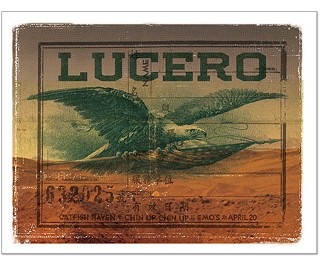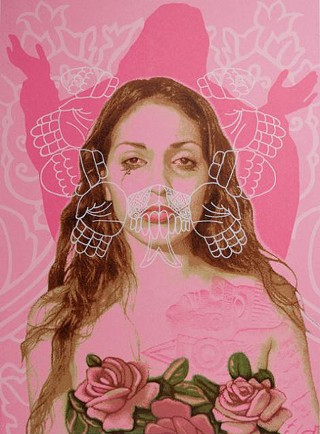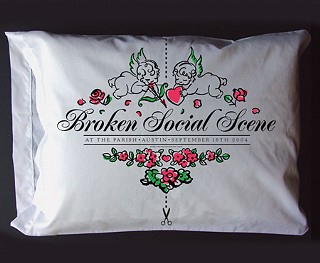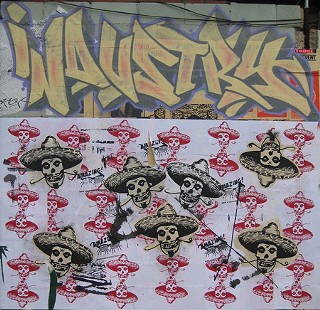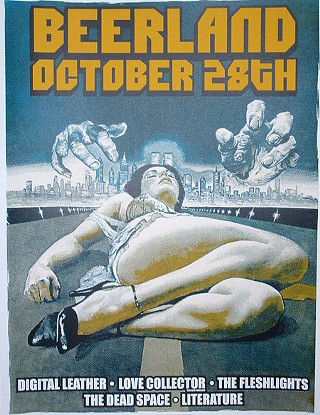The Art Is Formally Known as Prints
A somewhat kaleidoscopic glimpse of Austin's screen-printing scene
By Wayne Alan Brenner, Fri., Nov. 6, 2009
Take another look at the cover of this week's Chronicle. There's a giant crab attacking some modern metropolis, cars rupturing in its massive claws, telephone poles toppling, general megacrustacean havoc being wreaked. It's a beautiful work, rendered in several colors simultaneously, printed (with the rest of the issue) on newsprint via high-speed presses in the basement of the, well, the Austin American-Statesman, actually.
Imagine that same cover printed on poster board or thick archival paper. Imagine those colors applied separately, each by hand.
With screen-printing, it's one layer at a time. You're printing a poster for a band's latest gig, a T-shirt for a cultural event, a multidocument campaign for some new product, laying down one color at a time, over and over, forcing the ink through a fine screen until those layers of color build up into what's going to grab eyeballs most effectively. You're often doing this with your own hands, nothing more than your tiring human muscles powering the process.
Some people do this as a hobby or for a little extra moolah on the side; others do this as a full-scale business with employees and corporate accounts.
"When I first moved to town, I worked at Asel Art Supply on MLK, and they had a small Speedball silk-screening kit," says the man who created this issue's cover. "And only now do I realize how incredibly bad those products are." The man is Tim Doyle of Nakatomi Inc., one of the smallest and newest screen-printing studios in our ink-stained city. "But I taught myself how to do screen-printing with that little kit," he says, "and I made multiples of my work on canvas with it and had them showing around town for a while. So I essentially learned how to screen-print almost a decade ago, but never really worked on it as far as a vocation. But then I was art-directing the Alamo Drafthouse's poster series for years and working with screen-printers constantly, dealing with production, and the bug bit me, and I just really wanted to get my hands on a squeegee and do it for myself, you know? Because it seemed like a lot of fun and I was missing out by not actually doing it. So I started Nakatomi in January. This is its first year of business, and it's already making money."
Austin has a history of successful screen-print artists, whether we measure that success by fame or fortune or both. Guy Juke, Nels Jacobson (aka Jagmo), Jason Austin – legends all, and still working to one extent or another; a full list of notables might require destruction of a sequoia for printed display. And of course, any mention of Frank Kozik, whose unforgettable concert posters flourished like Day-Glo kudzu throughout Austin in the late Eighties and early Nineties, will grin the faces of pop-culture design aficionados from Madrid to San Francisco and all points between.
And now there are these new guys coming up. All these new guys, a lot of names, a lot of overlapping personal and business relationships. The scene's Venn diagram would resemble something from a kaleidoscope that had been attacked by a giant crab. This article, with its own staggered layers, is a brief look at part of that.
"When I started working at the Alamo in 2004 as their merchandise guy, I thought I was just gonna be running a T-shirt shop," says Doyle, lifting an inked screen that's laid down the first color of a new Paul Pope print. "But Rob Jones and I were able to build their poster series into a world-class thing, and we wound up getting to work with some incredible people, like Jay Ryan, Tyler Stout, great artists like that. Like Geoff Peveto of the Decoder Ring."
That's the Decoder Ring Design Concern, to be precise. It's a company at the end of the indie spectrum that's opposite from Nakatomi. Doyle works by himself, mostly, out of a tiny garage he jerry-rigged into a workspace, pulling limited-edition poster-and-T-shirt combinations that he releases, just one each month, for a rather geek-o-centric but international crowd of collectors. The Decoder Ring, on the other hand, is Geoff Peveto, Paul Fucik, and Christian Helms, and their two employees and an occasional intern, in much fancier studios; their client list boasts of work they've done for MTV, Obama for America, Modest Mouse, the Flaming Lips, Sony BMG, the New York Times, on and on. They're big, fierce, and – as you know if you've seen any of their work – talented. But, metaphorically speaking, even a giant, city-destroying crab must have begun as a much smaller baby crab, right?
"I've always been a music geek, always hanging out with bands," says Peveto, who is also president of the American Poster Institute (which he helped Frank Kozik start in 2002) and the driving force behind the international Flatstock poster convention. "And in college I was the guy with the computer, so people would say, 'Hey, make a flyer for us.' So I started out making crappy little 8-by-10 flyers. And then I met Paul Fucik at Coronado Studio, and I got into screen-printing. Paul pretty much taught me all the stuff I know. And we started a group called Factor27, with two other guys, Clay Ferguson and Jason Cross, and that lasted for about four years. Then Jason went off to architecture school and Clay drifted into doing vinyl toys, and Paul and I wanted to stick with graphic design. And at about that point I was introduced to Christian Helms, who'd just moved to Austin. He'd been interning at Pentagram-New York with Michael Bierut. And he'd just gotten sick of New York – he'd been to Austin once, and he liked it here – so he told everybody, 'To hell with this, I'm moving to Austin.' And a mutual friend of ours, Art Chantry, told him to look me up. So Christian called me out of the blue, and we went out and had a beer, and we hit it off. And I knew he was a great designer, so I said, 'You know, we're done with Factor27, why don't you join Paul and me in a new business?' And that's where the Decoder Ring came from. That was in 2004."
"Those Decoder Ring guys are definitely masters of their craft," says Tony Diaz. "Their posters are phenomenal." Diaz is the owner of Industry Screenprint, started in South Austin in 2007, now working out of a small warehouse space on the Eastside.
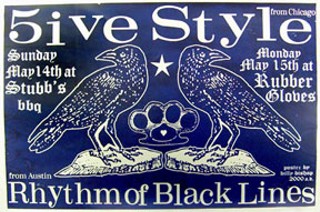
Bart Kibbe, who works with Industry when he isn't holding down his graphic designer position at the Austin Museum of Art, concurs. "You go see Decoder Ring; ask them to pull out the James Victore prints they did," he says, excitement sparking in his dark eyes. "Decoder does a series of fine art prints, and when I first saw this one print, I wanted to go and hang out there full-time, just go and be an intern and learn how the hell they do that, you know? There's one piece where Victore spelled out the type with duct tape. And they scanned that piece, and then they printed it, and you look at the print, it's right there in front of you, it's ink, but you'd swear it was actual duct tape. They used six or eight different colors for that print – just for the duct tape. And, what, eight more colors after that? They'd burned, like, 16 fucking screens for that one print. And I'm looking at it, and I just can't wrap my mind around that."
Kibbe and Diaz work the grungier side of the street, unleashing a more obviously DIY punk aesthetic – especially after hours. "That's the coolest thing about having this spot," says Diaz. "We screen-print during the day for clients, to pay the bills, and then we have all these resources available to produce our own art, our own art shows. We bring in the artists to use our equipment, and we have these awesome parties."
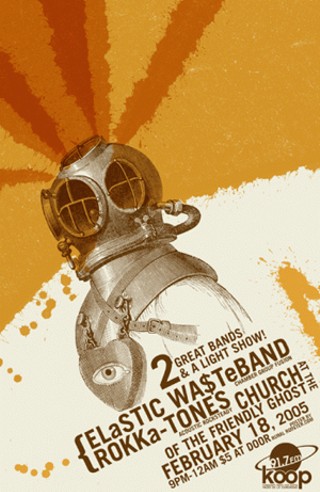
Together, Diaz and Kibbe have formed an Industry sideline: Print Addiction, which features a multiscreened printing rig that they'll truck out to public and private events to allow artists (or any print-curious citizens) to create their own posters or T-shirts right there. And as much as Kibbe would like to hang out at Decoder, the reverse is also true. "Paul Fucik recently started coming to Industry," says Kibbe. "He prints at Coronado Studio, and at the Decoder Ring, of course, but he pops in here sometimes, like, 'Hey, can I help out?' and gives us technical tips and so on."
You talk to screen-printers in Austin for a while, you keep hearing about Sam Coronado and his studio. Coronado started out as a technical illustrator for Texas Instruments back in 1969, ran several art galleries – he also took a little time out to be a co-founder of Mexic-Arte Museum – and eventually chose screen-printing as his major pursuit. Except that he calls it by its more formal name, serigraphy, a term coined by printers in the 1930s who wanted to differentiate the artistic process from its more industrial use, which suggests an operational precision and an aesthetic delicacy a neighborhood or two away from the beer-fueled Van Son hoedowns of Print Addiction. The people who do their work at Coronado Studio, in general or as part of the Serie Project that promotes work by Latinos in particular? Those people are fine artists, regardless of what partly commercial situation they wind up in next.
"Sam Coronado was my instructor," says Kibbe. "I took drawing classes from him. And the Serie Project is amazing. It turned me on to this whole new level and gave me a lot of ideas. They take guys who have never screen-printed in their lives, and they're sitting there, doing these color separations by hand with grease pencils or whatever. The one time I saw them working, this guy had a painting, and he was putting vellums over it and blackening in the colors for the film positive, one vellum for each color. And it was, like, a dozen-color screen print."
Although the point of screen-printing is often, we're told, to use the fewest colors necessary.
"The kind of thing that tends to be the most difficult, when it's flat work on paper, is when people have really ambitious visions that won't translate that well to screen-printing," says J.J. Campbell of Rural Rooster. Campbell's been in business since 2002, having started out of his house after college and now operating in a small space near Capitol Plaza in the Windsor Park neighborhood. "Like when they need the colors to be 100 percent on, with inks that are hand-mixed," he says. "It's not like the Pantone Matching System, so sometimes the luminosity of it is more than we can provide. Or they have, like, Photoshop effects that won't work without having to print 20 colors, you know? When you're trying to keep the budget down, you try to minimize the colors, but you're dealing with gradients and transparent overlays and everything. So there's creativity just in problem-solving with the printing process, like when you're taking something that's 30 colors and trying to make it work with just six or eight, taking care of the separations. That can be fulfilling, too."
"But screen-printing can be so simple," says Kibbe at Industry, helping Ryan Cross (an artist who also works across town at Rural Rooster) move a pile of black T-shirts printed with a sombrero'd skull design by the Amazing Hancock Brothers. "I can start with a Xerox or a painting, and within an hour I'll be pulling prints – there's that artwork on a piece of paper or shirt. And that's more accessible. Like, I'll sell my original piece of artwork for 200, 300 dollars, if I'm that fond of it, if I've spent like six or 10 or 12 hours working on it. But if I reproduce it as a screen-print, letting go of one of the prints for 20 bucks is easy, and it's available to everyone."
It's available to everyone, yes; it's a more democratic, less elite type of artwork. Like the food at Stubb's, say, where there are plenty of gig posters to be seen at all times and where you may have learned the venue's culinary offerings from a menu board designed by yet another screen-print studio: Bearded Lady. J.D. Fanning and Josh Chalmers started the studio in 2002 to promote their Perverted Son record label, but eventually realized they were more about the design and the ink than they were about the notes and the recording. Now they're working out of an East Austin studio, holding shows in their workspace's lobby, and creating posters and promotional material for all manner of bands and events.
There are many more screen-print studios like that in Austin, of course, along with the others we've briefly spotlighted here, and they're also interconnected in a hypertrophied Venn diagram sort of way. We can't possibly illuminate all of them for you, friend, but we ask you to imagine. Imagine that this partial coverage isn't due to editorial necessity, to restrictions of reporting time or available column-inch space. Imagine that it's due to the giant crab, having had its way with whatever urban center is Doyled on the Chronicle's cover, now terrorizing the more green and granola'd heart of this river city. Imagine that crab's ichor-dripping mandibles nomming the upper deck of I-35, the impact of its spiny legs causing Obsolete Industries' Billy Bishop to ditch his ink-smeared squeegee and hide under the bed above his studio. Imagine one enormous claw smashing through a brick-bordered Chronicle window and grabbing an Arts writer who ....






